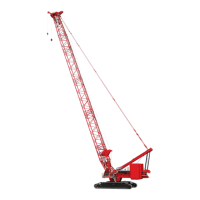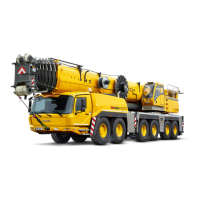OPERATING CONTROLS AND PROCEDURES MLC650 OPERATOR MANUAL
3-60
Published 08-12-19, Control # 224-13
CRAWLER BLOCKING
To prevent the crane from tipping, some boom and jib
lengths require blocked crawlers. See the appropriate
Liftcrane Boom or Jib Capacities chart for blocked crawler
requirements.
For crawler blocking dimensions and instructions, see the
Crawler Blocking topic in the Capacity Chart Information folio
located in the Capacity Chart Manual supplied with the
crane.
INTERMEDIATE SUSPENSION
If required per the rigging drawing in use (boom and luffing
jib), make sure the intermediate suspension is properly
installed. Otherwise, damage to the boom sections can
occur.
For some boom and luffing jib configurations, it is normal for
the intermediate suspension to appear slack during boom
and luffing jib raising and operation. If your intermediate
suspension appears slack —
• make sure it is installed in the proper location,
• make sure the proper pendant buttons are pinned to the
sockets,
and continue operation.
PREPARING CRANE FOR OPERATION
DANGER
Tipping Hazard!
Do not attempt to raise or lower the boom or the boom
and jib from or to ground level until the crawlers are
blocked, if required. Otherwise, the crane will tip.
WARNING
Read Capacity Charts
Do not attempt to operate the crane without first reading
and understanding the capacity charts located in the
Capacity Chart Manual provided with the crane.
The crane must be rigged and operated according to the
instructions given in the capacity charts, in Section 4 of
the MLC650 Operator Manual, and in Section 4 of the
MLC650 Luffing Jib Manual.
Unless otherwise specified in the capacity charts, all
crane operations must be performed with the crane level
to within one 1% of grade in all directions — 0,3 m in 30 m
(1 ft in 100 ft); otherwise, crane could tip.
Do not operate the crane—including raising the boom
from ground level—if the wind speed exceeds the limits
given in the capacity charts. Contact your local weather
station for the wind velocity in your area.
Failing to comply with the requirements of the capacity
charts can result in tipping or structural failure of the boom
or luffing jib.
Equipment Failure Hazard
At low ambient temperatures, dynamic loads (impact and
shock) can affect the steels used in Manitowoc cranes
when operating in cold weather. Read and comply with
Cold Weather Operation on page 3-77
before operating
the crane.
Moving Load Hazard
The operator shall select the proper crane capacity chart
in the RCL/RCI Display before operating.
Unexpected drum motion or improper limit responses can
result if the wrong capacity chart is selected.
The limit bypass switch shall be in the enable position (on)
and all the limits with which the crane is equipped shall be
operational before operating the crane.
Avoid Injuring Personnel in Operating Area
Sound the horn to alert personnel that operation is about
to begin.

